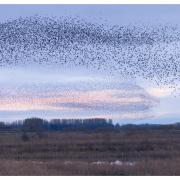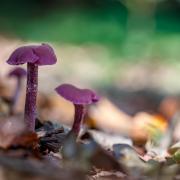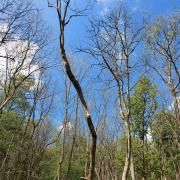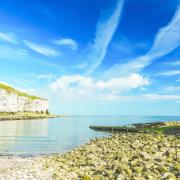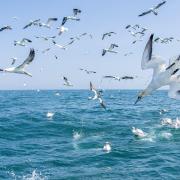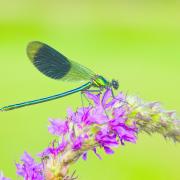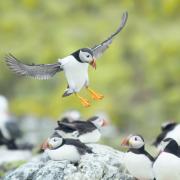From leaping salmon to the world’s fastest bird and mighty whales to the most delicate of dragonflies and orchids – Yorkshire’s wild side has it all. Tom Marshall picks out some unmissable spots to enjoy this year


Wykeham Forest Whether high in the woodland canopy or down in the lowlands of Troutsdale, this part of the North York Moors is home to some of our rarest wildlife. A ‘raptor watchpoint’ gives a perfect vista for seeking out a soaring honey buzzard during the summer months, or perhaps the magnificent goshawk. Passing ospreys in spring and autumn are possible too, along with hobbies, and the woodlands remain one of the last refuges for the increasingly scarce turtle dove. www.forestry.gov.uk

Snaizeholme, Hawes Surely a strong candidate for Britain’s cutest creature, the diminutive red squirrel is more typically associated with Scotland but can be found in the heart of the Yorkshire Dales at Snaizeholme. This specially protected wooded valley provides a chance to spot ‘reds’ with their rusty coat and tufty ears as they scamper between the trees and along ancient-looking bright green mossy walls. Red deer may skulk among the trees too, and in the canopy above listen out for siskins and crossbills. natureinthedales.org.uk

Whitby whales From around August – October every year, minke whales make a journey down Yorkshire’s rugged coastline in search of herring and mackerel. At over 30ft and weighing in at five tonnes, unbelievably they’re still one of the world’s smallest whales. You can enjoy an eye-to-eye encounter with these magnificent mammals by taking dedicated boat trips from Whitby harbour, or try your luck during calm conditions from mainland viewing points like Filey Brigg or Staithes. Some years have seen larger species like humpbacks join the action too. whitbywhalewatching.net

Malham Cove The natural limestone arena of Malham Cove is a fitting location for a show from perhaps the world’s greatest – and certainly fastest – aerial hunter. With many of their cousins embracing an urban lifestyle in recent years, the peregrine falcons of Malham are still masters of all they survey in their 260ft high-rise residence in the Dales. Late summer is a great time to see the adults training the attentive youngsters with swooping and diving displays. The nearby river valleys are home to redstarts and dippers, while the moors above echo to the call of the curlew. yorkshiredales.org.uk

Stainforth Force, Settle The life of an Atlantic salmon is a remarkable one and autumn offers the chance to experience the most energetic part of the salmon’s life cycle – the annual breeding ‘run’. From far out at sea, the fish wind their way up several of the county’s rivers during October and November, eventually having to leap several feet up the torrents of water at locations like Stainforth Force. Try early morning or late evening on overcast days after rain, for a chance to see up to 17 kilos of prime salmon undertake this feat of endurance. www.visitsettle.co.uk/stainforth-force.html

Bempton and Flamborough Cliffs With more than a quarter of a million seabirds along just a couple of miles of coastline, the RSPB’s Bempton Cliffs and nearby Flamborough Cliffs managed by the Yorkshire Wildlife Trust are two of the UK’s finest wildlife destinations. Amongst thousands of gannets, razorbills, kittiwakes and gulliemots are several hundred pairs of puffins – one of the only mainland locations for spotting these birds in the country. Such a concentration of birds comes under the watchful eye of peregrine falcons, while in winter the clifftop fields are patrolled by short-eared and barn owls. Boat trips from North Landing and Bridlington can give you a seal’s eye view of the action too. rspb.org.uk (Bempton) ywt.org.uk (Flamborough)

North Cave Wetlands, Brough Unlike the dazzling displays and rush to breed during the summer months, for our waterbirds, winter is the time to put on a show. North Cave Wetlands is a remarkable man-made nature reserve forged from the diggers’ bucket following gravel works, and is fast becoming one of the most popular birdwatching locations in the region. Vast flocks of ducks include teal, wigeon and shoveler, while the exquisite pintail and goldeneye often make a regular appearance. The skies above are frequently home to peregrines and harriers and kingfishers have bred in recent years. ywt.org.uk

Staveley, Boroughbridge The quiet tranquillity of Staveley is complimented in spring and summer with a profusion of purples, greens and yellows as meadows come alive with ragged robin, orchids and ox-eye daisies. Hidden amongst the meadows, dragonflies like migrant hawkers find plenty of pools to patrol and butterflies like the orange-tip feed on lady’s smock. The calm and reed-fringed shallow pools are perfect for otters – look out for the tell-tale trail of bubbles on the surface, or spot sand martins and terns in their specially designed homes on the reserve. ywt.org.uk

Spurn Unlike anywhere else in the county, Spurn Point could be considered the nearest thing in Yorkshire to Land’s End. Around 45 minutes east of Hull, this 3.5 mile strip of dunes stretches a long sandy finger into the Humber Estuary and North Sea. Such a unique location in the landscape makes it a mecca both for rare migratory birds and insects blown off course, but also for vast winter flocks of wading birds like dunlin, knot and plovers. These in turn attract the attention of peregrine falcons, merlins, short-eared owls and harriers. Summer nesting species include elegant little terns and avocets at nearby Kilnsea Wetlands, plus an array of dragonflies and butterflies. A newly renovated 128ft lighthouse and regular 4x4 ‘Spurn Safaris’ with the Yorkshire Wildlife Trust add to the sense of adventure alongside a rich wartime and cultural history. ywt.org.uk
Potteric Carr, Doncaster This Yorkshire Wildlife Trust reserve is just a stone’s throw from Doncaster and is a great place to enjoy a wild family day out or give your little ones a first taste of the outdoors. Spot grass snakes slithering through the pools, take in the resonating ‘boom’ of a bittern hidden amongst the reeds or look out for the fiery red eye of a rare black-necked grebe. All-access paths and trails bring you close to a huge array of dragonflies, butterflies and orchids and everyone can reflect on the day’s discoveries in the café hidden among the woodland. ywt.org.uk












